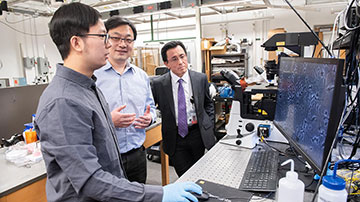![]()
Pengju Li holds a prototype pacemaker made of a specially engineered membrane. At just one-fiftieth of a gram, it is significantly smaller and lighter than current pacemakers. [Image: Jean Lachat, courtesy of the University of Chicago]
Artificial cardiac pacemakers regulate millions of human hearts, but current designs can suffer multiple types of failures and require intrusive replacement of their electrochemical batteries.
To address these issues, researchers have devised a thin, lightweight prototype pacemaker that stimulates cardiac tissue surfaces with tiny silicon devices that convert light into electrical currents. (Nature, doi:10.1038/s41586-024-07016-9). This new technology has been tested only on animal models, so it’s still a long way from the first clinical trials on humans.
The right silicon chip
Before constructing the full pacemaker, Bozhi Tian and his colleagues at the University of Chicago, USA, had to find the right type of silicon for the photodiodes that would stimulate the cardiac tissue in the right places. One type of silicon diode called a porosity-based heterojunction provided the highest photocurrent with the best signal localization―an important consideration when matching an external stimulator to the most receptive points of the heart muscle.
The team then applied the photodiodes, implanted in a 1-μm-thick, flexible membrane, to cardiomyocytes (heart muscle cells) in progressively more realistic situations, starting with cells growing in a glass-bottomed culture medium. Successive experimental rounds involved an isolated rat heart, then a heart inside a living rat and finally a living pig, whose heart functions much like that of a human.
In all cases, the researchers stimulated the silicon devices with 635-nm laser light. Tian says the team has not yet evaluated other near-infrared wavelengths. “It's feasible to employ NIR light of longer wavelengths, but it's important to note that due to silicon's bandgap of 1.1 eV, wavelengths cannot exceed approximately 1100 nm,” he says.
Moving to humans
The team conducted its experiments with the living hearts exposed, but that won’t be possible in human patients, who expect to get up and walk around. Tian says the light-powered pacemaker will need to get its signals from implantable optical fibers.

From left: Pengju Li, Bozhi Tian and Narutoshi Hibino review results in Tian’s lab at the Gordon Center for Integrative Sciences. [Image: Jean Lachat, courtesy of the University of Chicago]
“In our experiments with the pig model, the optical pacing was successful on the first attempt, which was unexpectedly impressive, as we had not anticipated such effective results,” Tian notes.
Over time, the thin silicon membrane that holds the photodiodes in place actually dissolves into harmless silicic acid. According to Tian, researchers could modify either the surface or internal structure of the membrane to alter its dissolution rate, but the device would be designed for temporary rather than long-term use.
Next, the team will refine the techniques for delivering the photostimulation within a closed chest, as well as the surgical implantation of the device. Tian, surgeon Narutoshi Hibino and doctoral candidate Pengju Li are forming a startup company with the goal of commercializing the technology over the next five years.
